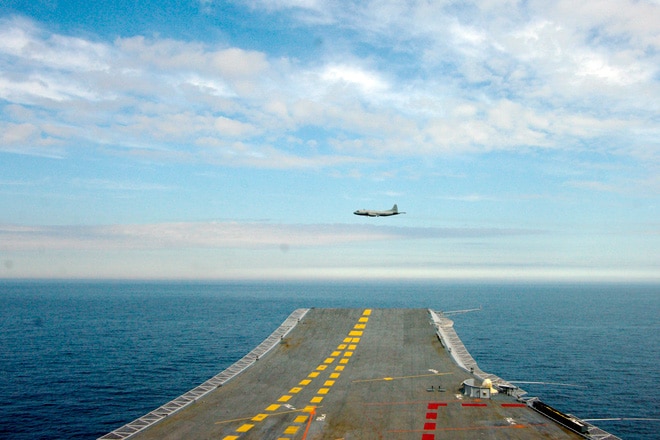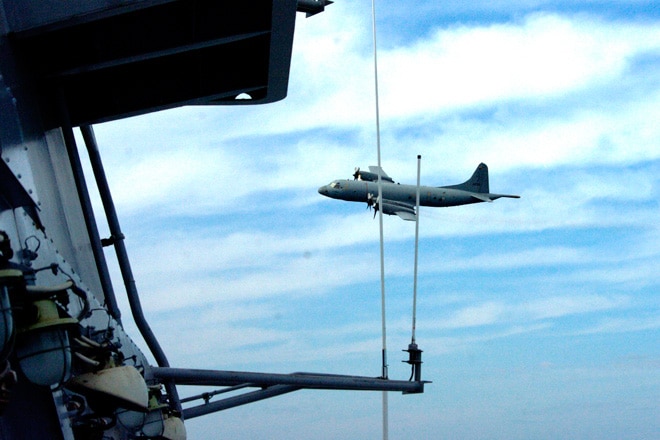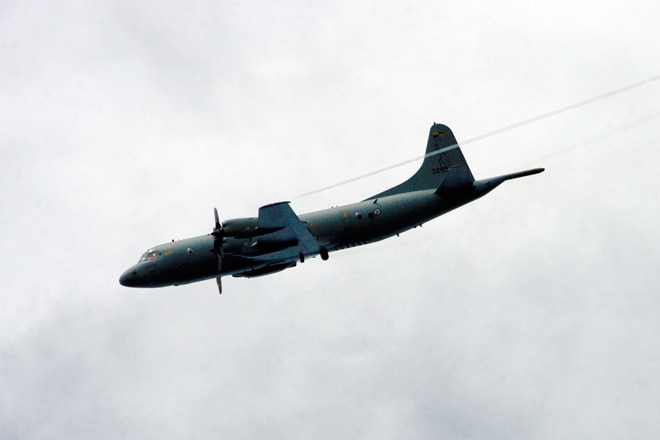Major Shaitan Singh
SENIOR MEMBER

- Joined
- Dec 7, 2010
- Messages
- 3,550
- Reaction score
- 43
- Country
- Location
USS / light multi-purpose aircraft carrier - a variant of restructuring heavy aircraft carrier aircraft carrier with springboard (angle of 12.5 degrees) normal take-off deck aircraft. On the ship dismantled weapons, upgrade equipment.
The ship is designed for the Indian Navy, and under the name of "the Vikramaditya" is being upgraded at "Sevmash" (Severodvinsk). Designer - Neva Design Bureau, Chief Designer - B.V.Shmelev. The project includes two starting positions with gaz baffling shields. Installation of REO and Indian systems of production to be carried out in India at the shipyard in g.Kochine. Transfer the carrier of India of 2010 (and later) is planned for 4 December 2012. In connection with malfunctions boilers propulsion system found to September 17, 2012, the ship was returned for improvements at "Sevmash". Final transfer of a ship in India is planned for the end of 2013
The first touch of the MiG-29KUB deck of aircraft carrier poizvedeny July 17, 2012, the crew - Diorditsa Nikolay and Mikhail Belyaev. The first landing on the deck of the aircraft carrier took place July 29, 2012 made a landing MiG-29KUB crew - Diorditsa Nikolay and Mikhail Belyaev. On the same day the plane took off from an aircraft carrier and re-planting.
March 27, 2013 Guidance on "Sevmash" has acted with a number of applications :

Return to Severodvinsk to test pr.11430 aircraft carrier "Vikramaditya", 20.09.2013 (photo - Oleg Kuleshov,http://kuleshovoleg.livejournal.com/ ).

USS pr.11430 "Vikramaditya" on the sea trials. 2013 ( http://www.livefistdefence.com/ ).

USS pr.11430 "Vikramaditya" goes to sea for sea trials. Severodvinsk, 3 July 2013 (photo - Yuri Gnatyuk, http://gnatyuk.livejournal.com/).

USS pr.11430 "Vikramaditya" in the Barents Sea, 14-15 September 2012 (photo - Igor Kondranin, source ).

INS Vikramaditya aircraft carrier of the Indian Navy and the SSBN "Dmitry Donskoy" pr.941UM at "Sevmash" in Severodvinsk, photo - November 2011 (photo from nosikot, archive http://navy-rus.livejournal.com ).
On sea trials after repair ship came July 3, 2013 After the successful completion of courses and flight test an aircraft carrier 20 September 2013 returned to Severodvinsk.
November 16, 2013 in Severodvinsk aircraft carrier "Vikramaditya" pr.11430 transferred to India. On the ship hoisted the Indian flag and the November 26, 2013 the ship departed from Severodvinsk to India. In January 2014 the ship is expected to arrive to the shores of India and the start of operation in the Indian Navy.
Construction - body has 18 major transverse and longitudinal watertight bulkheads 2. Unsinkable ship is provided in case of flooding of any 4 adjacent compartments. The walls of the hangar had a book unlike previous ships of the project, which led to an increase in the displacement of 1,700 tons.


Model aircraft carrier museum in pr.11430 Nevsky PKB ( http://pilot.strizhi.info )
The ship is designed for the Indian Navy, and under the name of "the Vikramaditya" is being upgraded at "Sevmash" (Severodvinsk). Designer - Neva Design Bureau, Chief Designer - B.V.Shmelev. The project includes two starting positions with gaz baffling shields. Installation of REO and Indian systems of production to be carried out in India at the shipyard in g.Kochine. Transfer the carrier of India of 2010 (and later) is planned for 4 December 2012. In connection with malfunctions boilers propulsion system found to September 17, 2012, the ship was returned for improvements at "Sevmash". Final transfer of a ship in India is planned for the end of 2013
The first touch of the MiG-29KUB deck of aircraft carrier poizvedeny July 17, 2012, the crew - Diorditsa Nikolay and Mikhail Belyaev. The first landing on the deck of the aircraft carrier took place July 29, 2012 made a landing MiG-29KUB crew - Diorditsa Nikolay and Mikhail Belyaev. On the same day the plane took off from an aircraft carrier and re-planting.
March 27, 2013 Guidance on "Sevmash" has acted with a number of applications :
- - boiler repair the main power plant of an aircraft carrier to be completed in May 2013
- - the test carrier is scheduled for July 3 (26/6/2013 was confirmed) 30 September 2013 .
- - during state testing on board the aircraft carrier will be the same and the Indian crew - 1326 people.
- - Joint Test Wing and the ship is scheduled to begin August 3, 2013 in the Barents Sea (confirmed 26.06.2013 city).
- - November 15, 2013 is planned to transfer an aircraft carrier of the Indian Navy, followed by a transition to a place of permanent basing - India (confirmed 26.06.2013 and of 09.29.2013, the).

Return to Severodvinsk to test pr.11430 aircraft carrier "Vikramaditya", 20.09.2013 (photo - Oleg Kuleshov,http://kuleshovoleg.livejournal.com/ ).

USS pr.11430 "Vikramaditya" on the sea trials. 2013 ( http://www.livefistdefence.com/ ).

USS pr.11430 "Vikramaditya" goes to sea for sea trials. Severodvinsk, 3 July 2013 (photo - Yuri Gnatyuk, http://gnatyuk.livejournal.com/).

USS pr.11430 "Vikramaditya" in the Barents Sea, 14-15 September 2012 (photo - Igor Kondranin, source ).

INS Vikramaditya aircraft carrier of the Indian Navy and the SSBN "Dmitry Donskoy" pr.941UM at "Sevmash" in Severodvinsk, photo - November 2011 (photo from nosikot, archive http://navy-rus.livejournal.com ).
On sea trials after repair ship came July 3, 2013 After the successful completion of courses and flight test an aircraft carrier 20 September 2013 returned to Severodvinsk.
November 16, 2013 in Severodvinsk aircraft carrier "Vikramaditya" pr.11430 transferred to India. On the ship hoisted the Indian flag and the November 26, 2013 the ship departed from Severodvinsk to India. In January 2014 the ship is expected to arrive to the shores of India and the start of operation in the Indian Navy.
Construction - body has 18 major transverse and longitudinal watertight bulkheads 2. Unsinkable ship is provided in case of flooding of any 4 adjacent compartments. The walls of the hangar had a book unlike previous ships of the project, which led to an increase in the displacement of 1,700 tons.


Model aircraft carrier museum in pr.11430 Nevsky PKB ( http://pilot.strizhi.info )
Last edited:



















































































